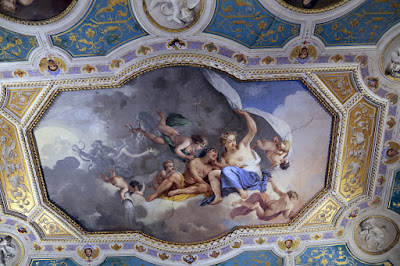 |
| Olimpio Bandinelli Allegory of the Four Elements Thetis receiving Armour for Achilles from Hephaestus ca. 1860 ceiling fresco Villa Favard, Florence |
 |
| Olimpio Bandinelli Allegory of the Four Elements Combat of Mars and Athena ca. 1860 ceiling fresco Villa Favard, Florence |
 |
| Olimpio Bandinelli Allegory of Night and Sleep ca. 1860 ceiling fresco Villa Favard, Florence |
 |
| Olimpio Bandinelli Allegory of Night and Sleep (detail) ca. 1860 ceiling fresco Villa Favard, Florence |
 |
| Olimpio Bandinelli Allegory of Night and Sleep - Lunette Figure ca. 1860 ceiling fresco Villa Favard, Florence |
 |
| Olimpio Bandinelli Allegory of Night and Sleep - Lunette Figure ca. 1860 ceiling fresco Villa Favard, Florence |
 |
| Olimpio Bandinelli Allegory of Night and Sleep - Lunette Figure ca. 1860 ceiling fresco Villa Favard, Florence |
 |
| Olimpio Bandinelli Allegory of Night and Sleep - Lunette Figure ca. 1860 ceiling fresco Villa Favard, Florence |
 |
| Olimpio Bandinelli Famous Loves ca. 1860 ceiling fresco Villa Favard, Florence |
 |
| Olimpio Bandinelli Famous Loves - Selene and Endymion ca. 1860 ceiling fresco Villa Favard, Florence |
 |
| Olimpio Bandinelli Famous Loves - Hermes and Pan ca. 1860 ceiling fresco Villa Favard, Florence |
 |
| Olimpio Bandinelli Famous Loves - Zeus and Ganymede ca. 1860 ceiling fresco Villa Favard, Florence |
 |
| Olimpio Bandinelli Famous Loves - Mars and Venus ca. 1860 ceiling fresco Villa Favard, Florence |
 |
| Olimpio Bandinelli Famous Loves - Figure of Mars ca. 1860 ceiling fresco Villa Favard, Florence |
 |
| Olimpio Bandinelli Famous Loves - Figure of Cronos ca. 1860 ceiling fresco Villa Favard, Florence |
"Villa Favard was built in 1858 at the behest of the Baroness Fiorella Suzanne de Bacheville, wife of Michele Favard. The title of baroness was never officially recognized. The architect who designed and built the villa was Giuseppe Poggi. The building has two floors and is surrounded by a garden. The rooms are decorated in an eclectic style typical of the nineteenth century. Fiorella Favard died in 1889 in Paris, but her request was to be buried in the chapel of Villa Favard. In the park in addition to the chapel, Fiorella Favard built a summer house, the stables and also a tomb for her dogs. In 1930 the villa became the seat of an American college for women. During World War II it was used by soldiers and later it belonged to the Opera della Madonnina del Grappa, a charitable institution. Today the villa is owned by the City of Florence and you can see it during your holiday in Tuscany while walking near the Lungarno Vespucci."
– Città di Firenze